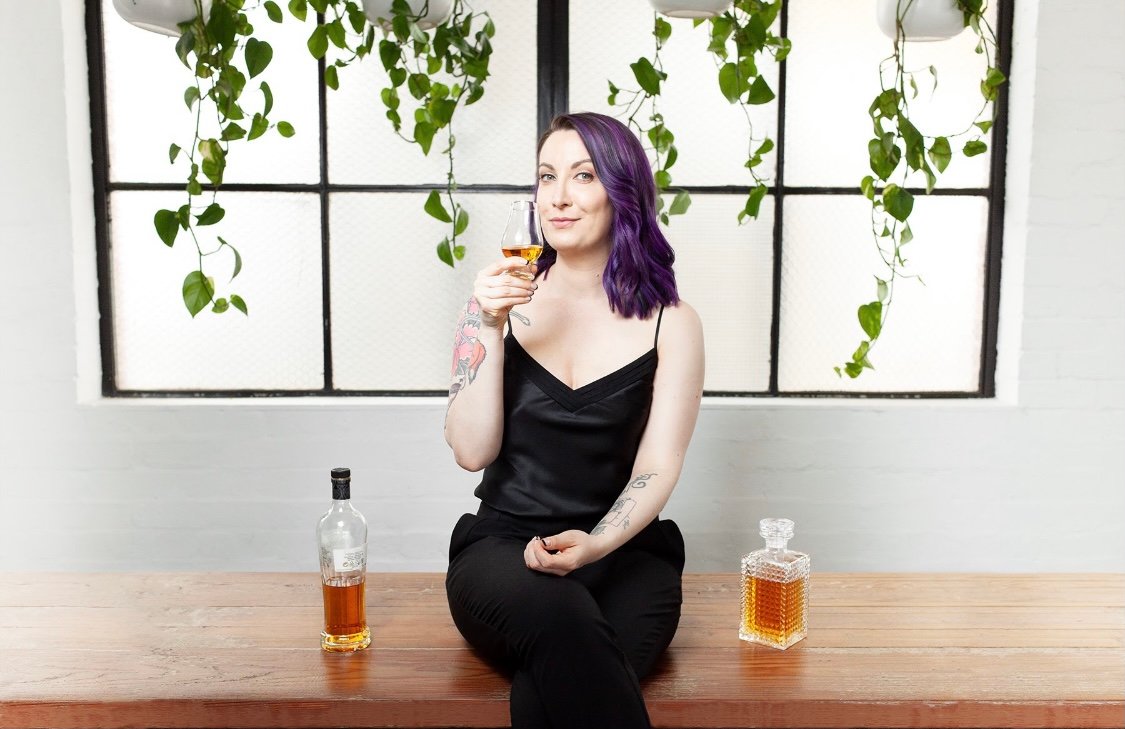Written by Mel Hack
Mel is a drinks writer and Whisky Production Assistant at Shelter Point, Vancouver Island, with a science-based education (Bachelor of Environmental Sciences, IBD certification). She previously worked at Whisky & Alement. Mel enjoys exploring the intersection of spirits, science, art, and sustainability through storytelling.
At a Whisky & Alement tasting last year, whisky enthusiast Ren Butler stumped the room with a simple question: “Why does this whiskey taste like pickles?”
No one had a clear answer—so I went digging.
Ever sipped a high-rye bourbon (like Mitcher’s) or a rye whiskey (like Bulleit or George Dickel) and been hit with a wave of dill pickle? Meanwhile, wheated bourbons (Maker’s Mark) or corn-heavy whiskies (Balcones) rarely have it. Even Australian rye whiskies like Belgrove show it, while others like Archie Rose don’t.
ADVERTISEMENT

 
If you’re new to Rye whiskey, here’s a quick explainer:
Ever had rye bread? Great! If not, it offers notes of nuts, caramel, vanilla, grass, malt, and baking spice, alongside hints of sourness, bitterness, burnt bread, and yeast.
Rye is most commonly made in the USA and Canada, and to be called a Rye Whiskey in the USA, it must be made from at least 51% Rye grain; the rest can be made with any other grain.
The other grains that can be included in Rye whiskey include wheat, barley, rice, oats, and even quinoa (only in Australia – Looking at you, Whipper Snapper Distillery in WA)! The grain is mostly unmalted, then milled into a fine powder-like substance, fermented with water and yeast (a ‘sour mash’ may be added, but we’ll get to that…) to make a ‘wash’ or ‘distillers beer’, distilled usually using a column still but sometimes a pot – or a combination of both! To no more than 160 proof, or 80% alcohol by volume (ABV), and matured for a minimum of 2 years in an oak cask – but don’t be fooled, it depends on the laws in which country it’s being made, and bottled at no less than 80 proof (40% ABV) – Unless you’re in Australia, that’s 37.5%.
If you want to get nitty gritty around Australian whisky laws, they’re fairly loose, and Luke Macarthy is your person to nerd out with – Find him writing the ultimate Australian whisky resource, Oz Whisky Review, which goes into depth: https://ozwhiskyreview.com.au/.
Fun fact: Canadian “rye” can legally contain 0% rye. (It’s wild, I know!)
The Pickle Flavour: Yeast, Bacteria, or Dirty Tanks?
I have hypothesised that when a grain whiskey is made with a sour mash bill and a high rye grain content, it creates the distinct taste that we all know and love or have flashbacks from – We love you Hatts & Tatts!
Setback vs. Sour Mash: The Science Behind Whiskey’s Secret Ingredients
I was told once by a fellow whisky expert and friend of mine to think of sourmashing like you’re making sourdough, but for whiskey.
You use a little bit of the last batch of bread dough — or in this case, whiskey — in each new batch. I interpreted that as if you’re taking a portion of the ‘mash’ (hence, sour-mash) from the previous batch, and adding it into the new one, like making a culture that way.
I learnt two years later, this isn’t necessarily true. It’s on the right track and partially true, with some holes in it, and needs some addressing.
Carmen Harwich, Master of Bourbon, Council of Whisky Masters and Starward National Brand Ambassador, reached out to the Master Blender of Woodford Reserve, Elizabeth McCall, for me last year to set the record straight:
At first glance, “setback” and “sour mash” might sound like interchangeable terms in whiskey production. But while they’re very closely related, they serve distinct roles in crafting your favourite bourbon or American-style Whisky. Let’s get into it!
Setback = Efficiency and Sustainability
Backset, also known as stillage or setback, is the acidic liquid left over after distilling the alcoholic wash. Packed with organic acids and yeast nutrients from fermentation, this byproduct is often recycled into the next mash—a key step in the sour mash process.
By adding backset to a fresh mash, distillers lower the pH, creating an environment that suppresses unwanted bacteria while promoting healthy yeast activity. This not only ensures a more consistent fermentation but also reuses heat and nutrients, making the process more efficient.
Think of it as giving the mash a head start:
Reduces Waste & Water Use – Instead of discarding stillage, distilleries reuse it, cutting fresh water needs by up to 45%.
Boosts Efficiency – Since it’s already warm from distillation, setback helps heat the new mash, saving energy.
Feeds the Yeast – Packed with nutrients from previous fermentations, setback acts like a yeast superfood, helping fermentation kick off faster and stronger.
A quick note: Regarding the dill pickle hypothesis, Hartwich and I have been whisky pen pals for a while, and I hypothesised to her that the chemical compounds in the sour mash fermentation can also create what is technically called lactic acid bacteria (LAB). I wondered if this is the underlying factor creating the dill pickle flavour, especially when rye grain is present.
I only just discovered from Elizabeth that you CAN add LAB deliberately to a mash, so I think we’re onto something here…
Sour Mash = Consistent Flavour
Sour mash, on the other hand, is all about control and consistency. It’s a fermentation technique that uses acidity (often from setback) to create the perfect environment for whiskey-making:
Lowers pH – A slightly acidic mash (like the sourdough bread starter) keeps bad bacteria at bay while letting yeast thrive.
Enhances Flavour – By stabilising fermentation, sour mash ensures each batch tastes like the last—a must for brands like Jack Daniel’s, Woodford Reserve or George Dickel.
Flexible Methods – While setback is a common way to sour a mash, some distilleries also use lactic acid bacteria for more precision.
How They Work Together
Setback and sour mash are a powerhouse duo:
Setback provides the “sour” – Its natural acidity jumpstarts the sour mash process.
Sour mash leverages that acidity – creating ideal conditions for fermentation and flavour development.
Fun Fact: Not all sour mash whiskey relies on setback—some use added bacteria—but all setback contributes to a sour mash when reused.
Why It Matters:
For Distilleries: Setback cuts costs and waste; sour mash ensures quality.
For Drinkers: These processes deliver the consistent, robust flavours we love in classic American-style whiskeys.
So next time you sip a bourbon, remember: setback is the unsung hero of sustainability, while sour mash is the guardian of flavour.
Back to the hypothesis:
Hartwich hypothesised, “Some flavours of rye specifically come from whether your yeast is what they call phenolic off note positive or phenolic off note negative.” Hartwich believes it’s got more to do with the yeast strain, which creates the chemical compound 4-vinyl guaiacol, more than anything else.

What is the simple answer for — ‘What the hell, is a Phenol? Carmen!’
Phenols are part of a large group of chemical compounds responsible for several qualities in beer, and whisk(e)y. Phenols can play positive and negative roles in flavour, mouthfeel, colour, and clarity. Regarding their flavour, they can be perceived as spicy, peppery, clove, smoky, barnyard, plastic, band-aid, and even medicinal. A whisky judge might use the term “phenolic” as an umbrella term for whiskies that have a combination of these more undesirable descriptors.
Miles Munroe – Master Blender for Westward Distillery in Oregon, USA, added his words of wisdom, and his insights were also wonderful:
“It’s definitely from bacteria, specifically lactic acid. Some makers who run super clean fermentations try to avoid that flavour in their whiskey, but it’s not technically considered a fault…it can either be from the backset or a not-quite-clean fermentation tank.”

Ev Liong, Ex-Bar Manager of Whisky & Alement and now Blender of spirits at Archie Rose Distillery in Sydney, gave her thoughts, “Maybe it’s perception, the texture isn’t as grippy on the palate as other aged spirits. Flavour-wise — It’s a mystery.”
As I am quite frankly a confessed nerd, which is no surprise to anyone who reads my content or meets me for 10 seconds. With a bachelor’s in environmental science and working in the field of whisky production now, I was surprised when there was limited scientific published material about this topic online, which got me even more curious.
However, Dr Livermore, who has a PhD in Brewing and Distilling, is the Master Blender of Hiram Walker & Sons Limited in Ontario, Canada – always has an educated opinion, and it always up for a chat! I found an interview back in 2018 with thewhiskycask.com, which interviews Dr. Don Livermore on this exact topic.
He explained: “Rye fermentations are very difficult to run; the fermenters are very difficult to clean. We take great care here to make sure everything is sterile – we want as clean fermentations as possible to make sure our whisky does not have that distinctive dill characteristic to it.”
Dr. Livermore also agreed with Munroe’s statement, “Now, getting dill in rye doesn’t necessarily mean it’s a fault. Some people like that characteristic in their Ryes, and there’s nothing wrong with that. After all, each one of us has our individual preferences.”
So there we have it, thanks for that thought-provoking question, Butler; we finally have an answer, I think?
It could be from the yeast strain, sour mash, setback, or, you’ve got some dirty ass ferment tanks that need cleaning — maybe all three? If you’ve gotten this far, thanks for getting nerdy with us. Cheers to that!




